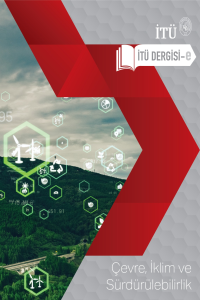Kâğıt endüstrisi atıksularında anaerobik mikrobiyal çeşitliliğin belirlenmesi
Bu çalışmada, kâğıt endüstrisi atıksularını arıtan gerçek ölçekli bir anaerobik kontak reaktörün 3 farklı yüksekliğinden 2 farklı zamanda alınan çamur numunelerinin mikrobiyal komünite yapıları Denatüran Gradyan Jel Elektroforez (DGGE) yöntemi kullanılarak karşılaştırılmıştır. 2 aylık izleme dönemi içinde sistem 2 hafta süreyle bakıma alınmıştır. Kontak reaktörün 1.6-1.8 kg KOİ/m3.gün organik yükleme hızında, KOİ giderim verimi % 47-55, metan üretim verimi 0.18-0.20 m3CH4/kgKOİgiderilen aralığında değişmiştir. DGGE analizleri sonucu, arkeyal popülasyona ait 31,
bakteriyel popülasyona ait 57 farklı tür tespit edilmiştir. Arkeyal popülasyona ait 3 farklı tür Ağustos 2005’te tespit edilememiş, buna karşın 6 yeni tür gözlenmiştir. Bakteriyel popülasyonda ise Temmuz 2005 numunesine ait 10 farklı tür Ağustos 2005 numunesinde tespit edilemezken Ağustos 2005’te 10 yeni türün varlığı gözlenmiştir. Bu çalışmada incelenen reaktöre ait asetoklastik metan üretim kapasitesi önceki bir çalışmada Spesifik Metan Aktivite (SMA) test düzeneği kullanılarak ölçülmüş ve potansiyel metan üretiminin yaklaşık % 45 azaldığı tespit edilmiştir. Sistemde bulunan metanojenlerin ve Sülfat İndirgeyici Bakterilerin (SRB) tür ve sayıları Floresanlı Yerinde Hibritleme (FISH) yöntemi ile belirlenmiştir. SMA testi ve FISH tekniği ile tespit edilen mikrobiyal komünite değişimi DGGE yöntemi ile de doğrulanmıştır. DGGE yöntemi, iki farklı zamanda alınan numunelere ait komünite değişimini açıkça yansıtmakla birlikte sayısal değerlendirmede yetersiz kalmaktadır. Bu nedenle, anaerobik reaktörlerin mikrobiyal komünite yapılarının gerek DGGE gibi detaylı kalitatif sonuç veren gerekse FISH gibi mikroskobik sayıma dayalı, kültürden bağımsız yöntemlerle çalışılması gerektiği sonucuna varılmıştır.
Anahtar Kelimeler:
Denatüran gradyan jel elektroforezi, arkeyal popülasyon, bakteriyel popülasyon, anaerobik kontak reaktör, kağıt endüstrisi atıksuları
___
- Amann, R.I., Ludwig, W. ve Schleifer, K.H., (1995). Phylogenetic identification and in situ detection of individual microbial cells without cultivation, Microbiological Reviews, 59, 143-169.
- Baier, U. ve Delavy, P., (2005). UASB treatment of liquid residues from grass bioraffination, Water Science and Technology, 52, 405-411.
- Barns, S.M., Fundyga R.E. ve Jefferies M.W., (1994). Remarkable archaeal diversity detected in a Yellowstone-national-park hot-spring environment, Proceedings of The National Academy of Sciences of the United States of America, 91, 5, 1609-1613.
- Buzzini, A.P., Sakamoto, I.K., Varesche, M.B. ve Pires, E.C., (2006). Evaluation of the microbial diversity in an UASB reactor treating wastewater from an unbleached pulp plant, Process Biochemistry, 41, 168-176.
- Gilbride, K.A., Lee, D.Y. ve Beaudette, L.A.,, (2006). Review: Molecular techniques in wastewater: Understanding microbial communities, detecting pathogens, and real-time process control, Journal of Microbiological Methods, 66, 1-20.
- Ince, O., Andersen G.K. ve Kasapgil, B., (1995). Control of organic loading rate using the specific methanogenic activity test during start-up of an anaerobic digestion system, Water Research, 29, 1, 345-355.
- Ince, O., Kolukirik, M., Ayman Oz, N. ve Kasapgil Ince, B., (2004). Comparative evaluation of full-scale UASB reactors treating alcohol distillery wastewaters in terms of perfprmance and methanogenic activity, Journal of Chemical Technology and Biotechnology, 80, 2, 138-144.
- Ince, O., Kolukirik, M., Cetecioglu, Z., Eyice, O., Tamerler, C. ve Kasapgil Ince, B., (2007). Methanogenic and sulphate reducing bacterial population levels in a full-scale anaerobic reactor treating pulp and paper industry wastewater using fluorescence in situ hybridization, Water Science and Technology, 55, 10, 183-191.
- Muyzer, G. ve Smalla, K., (1998). Application of Denaturing Gradient Gel Electrophoresis (DGGE) and Temperature Gradient Gel Electrophoresis (TGGE) in microbial ecology, Antonie van Leeuwenhoek, 73, 127-141.
- Muyzer, G., De Waal, E.C. ve Uitierlinden, A.G., (1993). Profiling of complex microbial populations by denaturing gradient gel electrophoresis analysis of polymerase chain reaction-amplified genes coding for 16S rRNA, Applied and Environmental Microbiology, 59, 3, 695-700.
- Øvreås, L., Forney, L., Daae, F.L. ve Torsvik, V., (1997). Distribution of bacterioplankton in meromictic lake Saelenvannet as determined by denaturing gradient gel electrophoresis of PCR-amplified gene fragments coding for 16S rRNA, Applied and Environmental Microbiology, 63, 9, 3367-3373.
- Raskin L., Stromley J.M., Rittmann B.E. ve Stahl D.A., (1994). Group-specific 16S rRNA hybridization probes to describe natural communities of methanogens, Applied and Environmental Microbiology, 60, 4, 1232-1240.
- Rincón B., Raposo, F., Borja, R., Gonzalez, J.M., Portillo, M.C. ve Saiz-Jimenez, C., (2006). Performance and microbial communities of a continuous stirred tank anaerobic reactor treating two-phases olive mill solid wastes at low organic loading rates, Journal of Biotechnology, 121, 4, 534-543.
- Rintala, J.A., Jain, V.K. ve Kettunen, R.H., (1999). Comparative status of the world-wide commercially available anaerobic technologies adopted for biomethanation of pulp and paper mills effluents, Proceedings, 4th International Exhibition and Conference on Pulp and Paper Industry, 519-540, New Delhi, India.
- Roest, K., Heilig, H.G.H.J., Smidt, H., de Vos, W.M., Stams, A.J.M. ve Akkermans, A.D.L., (2005). Community analysis of a full-scale anaerobic bioreactor treating paper mill wastewater, Systematic and Applied Microbiology, 28, 175- 185.
- Savant, D.V., Abdul-Rahman, R. ve Ranade, D.R., (2006). Anaerobic degradation of Adsorbable Organic Halides (AOX) from pulp and paper industry wastewater, Bioresource Technology, 97, 9, 1092-1104.
- Speece, R.E., (1996). Anaerobic biotechnology for industrial wastewaters. Archae Press, Nashville, TN.
- Sponza, D.T., (2002). Tetrachloroethylene (TCE) removal during anaerobic granulation in an Upflow Anaerobic Sludge Blanket (UASB) reactor, Journal of Environmental Science and Health. Part A, Toxic/Hazardous Substances & Environmental Engineering, 37, 213-236
- Stams, A.J.M, Elferink, S.J.W.H.O. ve Westerman, P., (2003). Metabolic interactions between methanogenic consortia and anaerobic respiring bacteria, in Advances in Biochemical Engineering/Biotechnology, 81, ed, Scheper, T., Springer-Verlag, 31-56, Heidelberg, Berlin.
- Yayın Aralığı: Yılda 2 Sayı
- Başlangıç: 2022
- Yayıncı: İstanbul Teknik Üniversitesi
Sayıdaki Diğer Makaleler
Kâğıt endüstrisi atıksularında anaerobik mikrobiyal çeşitliliğin belirlenmesi
Şükriye ÇELİKKOL, Bahar KASAPGİL İNCE, Mustafa KOLUKIRIK, Zeynep ÇETECİOĞLU, Orhan İNCE
Azo boyar madde üretimi atıksuların Foto-Fenton-benzeri ileri oksidasyon prosesi ile arıtımı
Gökçe TÜRELİ, İdil ARSLAN ALATON, Tuğba ÖLMEZ HANCI
Amoksisilinin anaerobik arıtılabilirliği
Zeynep KARTAL, Tuğba ÖLMEZ HANCI, İdil ARSLAN ALATON
Poliaromatik hidrokarbonların aerobik giderimlerine biyosürfaktanın etkisi
